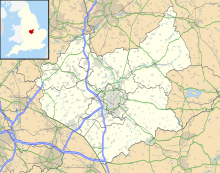RAF Bruntingthorpe
|
RAF Bruntingthorpe |
|||||||||||||||||||
|---|---|---|---|---|---|---|---|---|---|---|---|---|---|---|---|---|---|---|---|

B-47 Stratojet of the 100th Bombardment Wing parked at RAF Bruntingthorpe, 1958
|
|||||||||||||||||||
| Summary | |||||||||||||||||||
| Airport type | Royal Air Force station | ||||||||||||||||||
| Owner | Air Ministry | ||||||||||||||||||
| Operator |
Royal Air Force United States Air Force |
||||||||||||||||||
| Location | Bruntingthorpe, Leicestershire | ||||||||||||||||||
| Built | 1942 | ||||||||||||||||||
| In use | 1942-1962 | ||||||||||||||||||
| Elevation AMSL | 456 ft / 139 m | ||||||||||||||||||
| Coordinates | 52°29′49″N 001°06′48″W / 52.49694°N 1.11333°W | ||||||||||||||||||
| Map | |||||||||||||||||||
| Location in Leicestershire | |||||||||||||||||||
| Runways | |||||||||||||||||||
|
|||||||||||||||||||
Royal Air Force Bruntingthorpe or more simply RAF Bruntingthorpe is a former Royal Air Force station located 4.2 miles (6.8 km) north east of Lutterworth, Leicestershire and 10 miles (16 km) south of Leicester, Leicestershire, England.
It was operational between 1942 and 1962 and it is currently known as Bruntingthorpe Aerodrome.
The station was opened in November 1942 as home of No. 29 Operational Training Unit RAF (OTU) operating the Vickers Wellington.
After World War II ended, the airfield was used to test Meteor jet fighters. It was placed into RAF care and maintenance status and remained unused until January 1957.
On 13 November 1953, control of Bruntingthorpe was allocated to the United States Air Force, however the airfield remained unused for most of the decade.
In 1955, a massive reconstruction plan was approved to transform the airfield and station into a Strategic Air Command (SAC) bomber base. The USAF planned to use Bruntingthorpe as an advanced "Reflex" base for forward deployment of the new Boeing B-47 Stratojet medium range nuclear bomber. SAC wanted to disperse its nuclear bomber force and have about half of its B-47s stationed at forward bases in Western Europe and North Africa. Because the borders of the Soviet Union and Warsaw Pact controlled areas were within the range of the B-47, the "Reflex" deployments would base the bombers for 90-day rotations of crews and aircraft.
The wartime airfield's northeast/southwest runway was widened to 200 feet and increased in length from 6,000 to 10,800 feet in addition to a new parallel taxiway. To accommodate this, thirty-four farmlands were acquired to expand the size of the runway. In addition, a large dispersal area for aircraft parking, an underground refueling pipeline network and also the removal of the wartime crosswind runways. The station area required a large number of administrative and service buildings, a new main hangar, a new control tower and other airfield support buildings. Personnel barracks and other buildings, such as officer housing and, recreation facilities.
...
Wikipedia

